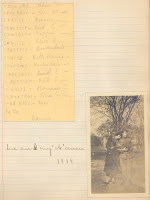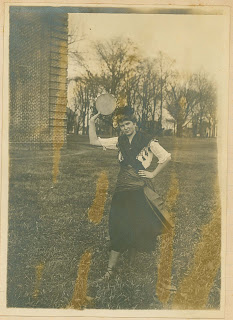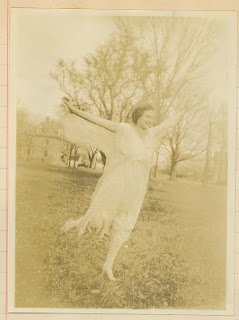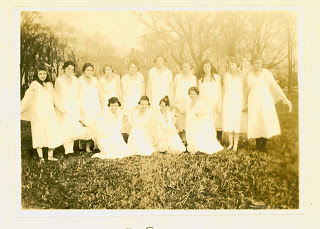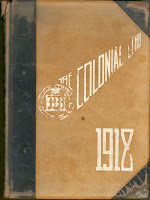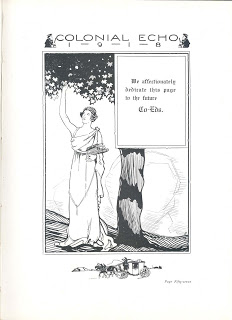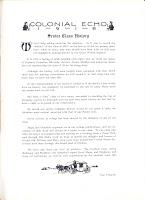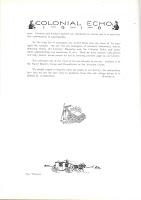It is the start of the 2008
Homecoming week at the College William and Mary. Ideally, this post would detail homecoming at the College in 1918, focusing on student activities leading up to an exciting football game. However, little information is available on the football season in 1918 and Homecoming was not marked at the College until 1926. With the demands of the
Students' Army Training Corps, scarce equipment, and no head coach, the success of the football team suffered.
The Colonial Echo yearbook of 1919 was understated in describing the season as "incomplete and rather unsuccessful."
Despite the lackluster performance of the football team, athletics played an important role on campus, and sports like basketball and baseball regained popularity after the end of
World War I.
Janet Coleman Kimbrough remembered the strong level of school spirit among the students in her oral history interview in the 1970s:
It was a period when college spirit was very strong. There wasn't any question about supporting your team; you just naturally did. We used to have rallies, (so-called), just before the big games of the season, and part of the initiation of the ducs [underclassmen] was that they were required to learn certain cheers. We didn't have girl cheerleaders at all. I don't remember even considering them. The cheerleader would have a megaphone and would direct the cheering, but there wasn't any special costume or special activity on the part of the cheerleader; he was just to see that everybody made noise.
Basketball was especially popular on campus. Women students played among themselves, separated into the "Orange" (sometimes called "Yellow") and "Black" teams. Student Martha Barksdale was widely recognized as one of the best players, and even admitted to letting the other team win once in a while to keep them interested in playing. They also participated in "aesthetic dancing," drilling (during the war), tennis, and swimming.
Members of the "Orange" team (top): Martha Barksdale, Catherine Dennis, Alice Person, Ruth Harris, Edna Reid, Celeste Ross. Members of the "Black" team (bottom): Elizabeth Scott, Margaret Thornton, Mary Haile, Margaret Bridges, Janet Coleman, Louise Reid, Alice Burke. From The Colonial Echo.
How male students might have supported women's basketball is unclear, but everyone seems to have cheered on the men's basketball team. According to Barksdale, students would ring the bells on campus after the men won a game, then gather for a celebratory bonfire and rally either on campus or on Duke of Gloucester Street. The police monitored these celebrations, occasionally arresting students for being too loud or for making the bonfire too large.
As part of Homecoming festivities, check out The Wham Bam Big Band performing at Swem Library on Friday October 24th at 3:30pm in conjunction with the exhibit "Ringing Far and Near: Student Music and Song at the College of William and Mary." Other events in Swem Library include: tours of the library this Friday and Saturday at 1:30, 2, 3:30, and 4pm; tours of the Media Center on Friday from 3-4:30pm; and Ben & Jerry's ice cream from 3:30-4:30pm.
Mary Comes to the College with William encourages students, alumni, and other visitors to enjoy Homecoming and celebrate responsibly (please, no bonfires). Editions of The Colonial Echo are available in the Special Collections Research Center and Swem Library. An excerpt of the transcription of Kimbrough's interview is available online and the complete transcription is available from the University Archives Oral History Collection in the Special Collections Research Center.
This post was composed by Kate Hill.
For additional information about the first women students at the College of William and Mary see: When Mary Entered with her Brother William: Women at the College of William and Mary, 1918-1945 by Laura F. Parrish; "The Petticoat Invasion": Women at the College of William and Mary, 1918-1945; The Martha Barksdale Papers; and the Women at the College of William and Mary page on the Special Collections Research Center Wiki.
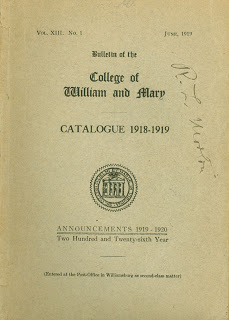 The June 1919 Bulletin of the College of William and Mary, which published the academic year catalogue 1918-1919, listed a new physical director of women, Bertha Wilder. This is inline with the hiring of new staff to oversee and educate the newly admitted Marys. Although Ms. Wilder is listed in the catagloue, her hire is not mentioned in the Board of Visitors meeting minutes. The catalogue defines and describes the necessity of physical education for women as
The June 1919 Bulletin of the College of William and Mary, which published the academic year catalogue 1918-1919, listed a new physical director of women, Bertha Wilder. This is inline with the hiring of new staff to oversee and educate the newly admitted Marys. Although Ms. Wilder is listed in the catagloue, her hire is not mentioned in the Board of Visitors meeting minutes. The catalogue defines and describes the necessity of physical education for women as 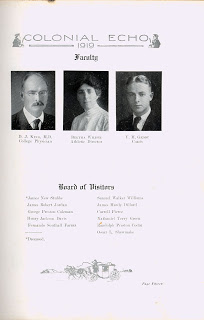 Direc
Direc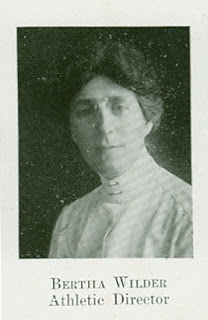 tor."
tor."